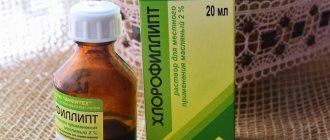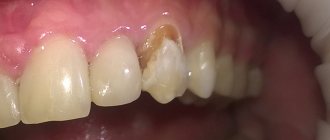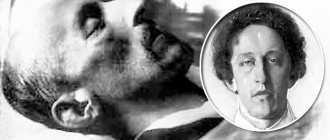Tonsillectomy for most patients with chronic decompensated tonsillitis is the method of choice and often the only treatment. In this regard, tonsillectomy is one of the most common planned operations in ENT surgical practice. This method of surgical treatment, according to various authors, reaches up to 40% of all surgical interventions on the ENT organs [1-3]. Indications for surgical intervention are frequent tonsillitis, as well as local complications of tonsillitis, such as peritonsillar abscess, retropharyngeal abscess, neck phlegmon, suppurating cervical lymphadenitis, febrile convulsions, severe tonsillogenic intoxication, diseases of distant organs and systems associated with pharyngeal pathology [4]. In the postoperative period after tonsillectomy, pain remains extremely relevant and in most cases the only symptom. The causes of pain immediately after tonsillectomy and in the next few days are the extensive open postoperative surface in the tonsillar niches, swelling and infiltration of the palatal arches [5]. The mechanism of post-traumatic pain is associated with an increase in the excitability of nociceptors resulting from the action of algogens - substances released from cells damaged as a result of surgical exposure (histamine, serotonin, ATP, leukotrienes, interleukin-1, tumor necrosis factor, endothelins, prostaglandins, nitric oxide, neurokinin , A, etc.) and formed in the blood plasma (bradykinin). Most often after surgery, patients are bothered by severe sore throat, which often radiates to the ears and also intensifies when swallowing [6]. In these cases, it is necessary to resort to painkillers, as well as follow a special diet that excludes coarse, salty, and spicy foods. Postoperative pain negatively affects the patient's eating and return to active daily life.
In addition, there is a danger of microbial contamination of the wound surface against the background of a decrease in local immunity and anti-infective resistance of inflamed tissues. In this regard, an important problem after tonsillectomy is to reduce the phenomena of reactive inflammation of tissues and reduce the pain syndrome that occurs in response to surgical trauma.
To achieve optimal analgesic effect after tonsillectomy, the use of a large number of different analgesic drugs is required.
According to the literature, over the years of tonsillectomy, multiple attempts have been made to improve pain relief in the postoperative period, both with systemic and local drugs. However, many of them have side effects and are poorly applicable in modern practice.
Opioid use has side effects such as nausea, vomiting, constipation, respiratory depression and severe sedation.
Nonsteroidal anti-inflammatory drugs (NSAIDs) increase the risks of bleeding and gastrointestinal disorders. According to experts, ibuprofen has some advantages in terms of tolerability over other non-steroidal anti-inflammatory drugs [7]. Cyclooxygenase-2 inhibitors (celecoxib) have similar analgesic properties to nonselective NSAIDs and have minimal side effects such as platelet dysfunction and gastrointestinal bleeding. However, one study showed that celecoxib does not provide sufficient analgesic effect after tonsillectomy and also often causes vomiting [8].
H. Tolska et al. [9] conducted a meta-analysis of 29 studies representing a double-blind, placebo-controlled, randomized trial of systemic analgesics used in the postoperative period after tonsillectomy. This study confirmed the beneficial analgesic effects of paracetamol, NSAIDs, dexamethasone, gabapentinoids and dextromethorphan after tonsillectomy on the day of surgery. Dexamethasone in multiple doses had an analgesic effect exceeding 24 hours. However, the use of steroids with high total doses and/or long-term use after surgery should be carried out with caution, taking into account the possible risks. Well-known side effects of systemic corticosteroid therapy (eg, moon face, Cushing's syndrome, diabetes mellitus) develop with long-term treatment. The risk of side effects from short-term, 1-2 weeks, systemic glucocorticosteroid therapy is minimal if treatment is not given to patients with diabetes, glaucoma, cataracts and osteoporosis. However, an increase in blood glucose levels and a rise in blood pressure can be observed during treatment with systemic glucocorticosteroids and in patients without diabetes mellitus or hypertension. A single dose of analgesics or the use of dexamethasone alone does not provide a clinically significant long-term analgesic effect after tonsillectomy.
A. Khan et al. found that gabapentin, pregabalin, and dextromethorphan may be useful in moderate doses as adjuvants to other analgesics. However, gabapentin and pregabalin are antiepileptic drugs, and dextromethorphan is an antitussive drug, and therefore their analgesic effect itself is not justified. Ketamine, an NMDA antagonist used as an anesthetic, can be used for pain relief after surgery. Its use in subanesthetic doses is effective in various types of surgeries to reduce opioid requirements and pain sensitivity. However, a patient receiving ketamine should be under constant medical supervision [10].
Thus, systemic analgesic drugs do not always have a good analgesic effect and in most cases have side effects. In this regard, in order to avoid the systemic effect of NSAIDs and at the same time ensure direct contact of the drug with the mucous membrane of the oral cavity and pharynx, it was necessary to develop local anesthetic drugs.
Topical drugs used in the complex treatment of pathological conditions of the oral cavity and pharynx can be divided into analgesics, anti-inflammatory drugs, antiseptics, drugs with a decongestant effect on the mucous membrane, etc. [11]. Local preparations in the form of lozenges, sprays, and rinses have also begun to be used in patients after tonsillectomy.
Many studies conducted in adult patients after tonsillectomy have shown the therapeutic effectiveness of benzydamine, especially when using a 0.15% mouthwash or spray - rapid relief of sore throat, reflex otalgia, and the absence of secondary bacterial complications were noted. However, in these studies there is mention of such an unpleasant sensation in some patients as a burning sensation in the throat associated with the ethyl alcohol contained in these drugs. This may indicate the irritating effect of these drugs, as well as the risk of bleeding from the tonsil niches [12, 13]. Topical therapy for the oropharynx may include rinsing, spraying, and lozenges. Rinsing with medicinal preparations is effective in treating the oral cavity and the base of the tongue. The use of a spray allows you to irrigate the back wall of the pharynx, however, the use of sprays is not recommended for children under 6 years of age and for patients with bronchial asthma. When assessing the effectiveness of medications in the form of resorption, it was noted that the concentration of active ingredients in the pharyngeal mucosa is higher than when using a spray and rinse. There is also a slower cleansing of the pharyngeal mucosa from drugs when using drugs in a resorption form, which ensures the maintenance of a high concentration of the drug at the site of inflammation [14].
In the search for non-pharmacological analgesia, various types of non-traditional approaches to pain management are being used. One such approach is transcranial electrical stimulation. It has been established that under the influence of this method the sensitivity of peripheral pain receptors decreases. This effect is caused by an increased concentration of β-endorphin circulating in the blood. However, this method has a number of contraindications and reduces the severity of pain for a limited period of time, and it is also economically unprofitable [15].
The use of a visual analogue scale (VAS) to assess pain allows us to assess the level of acute postoperative pain syndrome in patients who have undergone tonsillectomy [16].
In connection with the problem of pain relief for patients in the postoperative period after tonsillectomy, attempts have been made in recent years to produce new, safe, modern drugs. One of these drugs is Arnica Montana C9 (BOIRON) - a homeopathic monocomponent drug of plant origin.
The purpose of the study was to identify the effect of the homeopathic monocomponent herbal preparation Arnica Montana C9 (BOIRON) on the condition of patients who underwent tonsillectomy.
What is tonsillectomy?
Removal of palatine tonsils is one of the most common operations in the practice of an ENT doctor.
Many people think that it is performed only for children, but this is not so. Adults may also need it if chronic tonsillitis has become severe and is accompanied by purulent complications, and enlarged tonsils interfere with swallowing and even breathing, causing sleep apnea syndrome - a short-term cessation of breathing during sleep. The palatine tonsils sometimes become inflamed. Inflammation of the tonsils (tonsils) is referred to as tonsillitis. It, in turn, can be acute and chronic.
Inflammation of the tonsils. Photo: James Heilman, MD / (Creative Commons Attribution-Share Alike 3.0 Unported license)
Acute tonsillitis is called tonsillitis. With chronic tonsillitis, the inflammatory process lasts for years, with periodic exacerbations. An exacerbation is usually accompanied by fever, sore throat and sore throat, including when swallowing.
The tonsils become coated, bad breath appears, and the cervical lymph nodes become enlarged. If exacerbations recur one after another, and conservative treatment does not help, you have to resort to surgical treatment - removal of the tonsils (tonsillectomy).
Diagnostics
The need for tonsillectomy is determined by an ENT doctor after a conversation with the patient, a visual and instrumental examination, and obtaining the results of diagnostic studies. Laboratory tests and instrumental examinations not only indicate the presence of chronic tonsillitis, but also reflect the degree of influence of the inflammatory process on the body. Some of the tests and examinations are necessary to ensure that there are no contraindications to surgery.
Before removing tonsils, the following is prescribed:
- general blood test with leukocyte formula;
- blood chemistry;
- blood clotting test;
- blood for syphilis, HIV, hepatitis;
- rheumatic tests;
- general urine analysis;
- ECG;
- FLG;
- culture from tonsils.
Difference from tonsillotomy
Along with tonsillectomy, there is another operation with a similar name - tonsillotomy, in which enlarged tonsils are removed not entirely, but partially (usually in children). The indication for such an operation is the hypertrophy of these tonsils, when they occupy the entire space from the anterior palatine arch to the midline of the pharynx. With tonsillotomy, only the “excess” of enlarged tonsils is removed, returning them to normal size. Tonsillotomy is less traumatic than radical removal of the tonsils, and allows you to preserve their protective functions.
Complications and how to avoid them
One of the very rare complications: velopharyngeal insufficiency. After surgery, velum closure may be impaired. This complication is manifested by the appearance of a nasal voice in the patient, the appearance of snoring during sleep, and disturbances in the processes of speech and swallowing food. More often, this complication appears in patients with a hidden cleft of the hard palate that was not diagnosed before surgery. To exclude such a condition, a thorough examination of patients is necessary. One of the signs of the presence of a submucosal cleft of the hard palate is the splitting of the uvula.
Why doesn't conservative treatment help?
Due to immunodeficiency (congenital or acquired) or concomitant diseases that contribute to prolonged inflammatory processes (diabetes mellitus, chronic infection), conservative treatment of tonsillitis may be ineffective.
Important! Group A beta-hemolytic streptococcus can settle in the tonsils, which causes rheumatic damage to the heart, joints and kidneys. Removing the tonsils avoids these complications.
Other factors that complicate conservative treatment include smoking and alcohol abuse. For teachers, singers and actors, the risk factor is the need to talk long, loudly and a lot.
At what age is surgery performed?
Surgical treatment may be recommended for adults and children over 8 years of age. By this time, the tonsils are fully formed. The palatine tonsils are an integral part of the pharyngeal ring - a group of tonsils (paired palatine and tubal, unpaired nasopharyngeal and lingual) - an important organ of local immunity of the nasopharynx and respiratory tract. Early removal of tonsils can contribute to the development of atopic diseases - allergic rhinitis or bronchial asthma. Such operations are usually not performed on children under three years of age, since they rarely have tonsillitis - the tonsils are too small.
Important! Tonsils can be removed no earlier than six months after polio vaccination.
How is the operation performed?
Three hours before the start of the operation, the patient is not recommended to drink or eat. The patient is placed in a surgical chair, and his pharynx is treated with anesthesia. After the anesthesia takes effect, the doctor directs a special device that uses a laser beam to target the tonsils. To avoid burns and damage to healthy tissue, radiation treatment is carried out in 4-5 approaches, each laser session lasts approximately 10-15 seconds. To prevent bleeding, laser coagulation (sealing) of blood vessels is performed. Tonsil removal is performed when the patient pauses breathing after taking a deep breath. To completely remove purulent deposits, large depressions are artificially expanded, then they are smoothed out, and the scars are excised with a laser. Such manipulations make it possible to create a discharge of the contents of the lacunae of the tonsils. When performing tonsillectomy, purulent deposits of the tonsils are completely eliminated. In some cases, within one to two hours after surgery, to eliminate the risk of complications, the patient is monitored and then sent home. Since laser tonsil removal is the most gentle method of treatment, the doctor can perform this manipulation in several stages.
Contraindications
They can be absolute (excluding the possibility of tonsillectomy) and relative, when everything is postponed until the reasons preventing the operation are eliminated.
Absolute contraindications:
- diseases with increased bleeding: hemophilia, hemorrhagic diathesis, Werlhof's disease, agranulocytosis, leukemia;
- heart failure grade 2–3;
- acute infectious diseases and exacerbation of chronic ones;
- active form of tuberculosis;
- cirrhosis of the liver.
Relative contraindications:
- caries (before sanitation - dental prophylaxis of the oral cavity);
- inflammation of the gums;
- pustular diseases of the mouth and skin;
- ARVI and influenza;
- exacerbation (decompensation) of chronic diseases;
- menstruation;
- pregnancy after the 26th week due to the risk of premature birth.
A correspondent of the Kazanskie Vedomosti newspaper talked about this with Boris Revzin, an otorhinolaryngologist of the highest category at the ENT center of the city clinical hospital No. 16.
— Boris Arkadyevich, in what cases does the question of removing the tonsils arise? — Very often we remove tonsils when conservative treatment of chronic tonsillitis is ineffective. Chronic tonsillitis is a long-term inflammation of the pharyngeal and palatine tonsils, often accompanied by inflammation of the mucous membrane of the pharynx. If a person has frequent tonsillitis (more than twice a year), we first carry out conservative treatment. First of all, the patient is examined for microflora and its sensitivity to various medications (for this, a swab is taken from the throat). Next, rinsing of the lacunae of the palatine tonsils is prescribed to cleanse them of caseous plugs, massage of the palatine tonsils. And if this treatment does not produce results - namely, long-term remission, then in such a situation it is possible to perform a tonsillectomy - an operation to remove the tonsils.
We also perform this operation if chronic tonsillitis causes complications in the form of concomitant diseases: rheumatoid arthritis, endocarditis, inflammatory autoimmune diseases of the thyroid gland, chronic inflammatory kidney diseases.
The absolute indication for removal of the tonsils is a complication of tonsillitis such as a peritonsillar abscess. This is an acute inflammation in the peritonsil tissue, a severe purulent lesion of the oropharynx. It occurs when a sore throat is treated incorrectly, when, for example, a person does not take antibiotics or takes them incorrectly. Or in the absence of treatment for the disease.
— And how does removing tonsils solve the problem of frequent sore throat? — In cases where there are indications for tonsillectomy. The tonsils are a source of chronic infection for the body. Microbes live in their lacunae and caseous plugs are formed: waste products of these microbes, desquamated epithelium and food debris. Sometimes the tonsils, by their very structure, are very loose, with widened lacunae. In this case, food debris will often get stuck in them, which can lead to chronic inflammation.
In addition, if antibodies begin to be produced to the causative agent of inflammation, streptococcus, then after some time they attack the body’s own cells and tissues. Thus, here we are already dealing with the autoimmune nature of the disease, affecting the tissues of the heart, kidneys, liver, and thyroid gland.
— Why does the issue of removing the tonsils cause a lot of controversy and there is no consensus among doctors about whether the patient needs to take this step? What do you think about this? — Regarding tonsillectomy, there is often a lot of conflicting information in the media and on the Internet. This may be due to the fact that earlier, in the 1970s and 1980s, tonsils were removed very often; this did not always give the desired result. Now we carefully examine the patient before referring him for a tonsillectomy. Before this step, it is necessary to determine whether there are any other causes of tonsil disease. Maybe the tonsils suffer from problems of the upper respiratory tract, such as a deviated nasal septum with delayed nasal breathing and so on. Or, as often happens in the case of pharyngotonsillitis, the development of a chronic disease is provoked by the Helicobacter bacterium, which causes diseases of the gastrointestinal tract.
— What are the contraindications for this operation? - Absolute contraindication - blood diseases. Because tonsillectomy may cause heavy bleeding. Relative contraindications are severe somatic pathology: myocardial infarction, angina pectoris, severe heart and renal failure, high degree of hypertension, severe diabetes mellitus, active form of tuberculosis. You should not remove tonsils during menstruation, in the last months of pregnancy, or during acute infection. The operation is carried out no earlier than two to three weeks after suffering from a sore throat, flu or other illness.
— Can removal of the tonsils lead to a decrease in immunity? After all, they are part of the human immune system... - No, you don’t need to be afraid of that. First, we do not remove all lymphoid tissue. Lymphoid tissue is present both at the root of the tongue and in the nasopharynx. The lingual tonsil is also part of the immune system. After the tonsils are removed, they take over the function of the palatine tonsils. Secondly, diseased tonsils are no longer of any use: they do not protect a person from infection, but themselves are its source and poison the body.
— Is it true that after such an operation a person’s voice can become quieter? - No, her voice does not become quieter, except perhaps only in the first time after the operation.
— Is tonsil removal performed under general anesthesia? — We perform tonsillectomy under both local and general anesthesia. When choosing it, we look at the overall picture, the severity of the pharyngeal gag reflex. Because of this, not every patient can, in principle, have this operation without anesthesia. Therefore, if a person has a pronounced gag reflex, it is, of course, more advisable to perform a tonsillectomy under general anesthesia. Many patients themselves want to have this operation performed under anesthesia.
— How is tonsillectomy performed? — The operation lasts from 30 minutes to an hour, depending on the severity of the bleeding. This is a surgical operation during which a radio wave scalpel is used. This modern radio wave equipment can reduce bleeding. It is also used after direct cutting of the tonsils, when it is necessary to cauterize the bleeding vessels at the site of the removed organ. The radio wave coagulator does this superficially without causing severe burns.
By the way, I want to note that tonsillectomy is not the only type of surgery on the tonsils. There is also a tonsillotomy (partial removal of the tonsils), which is usually done for children if the tonsils are enlarged. And lacunotomy - when, after washing the tonsils, incisions are made on them with a radio wave scalpel in order to thus seal the recesses in the tonsils, preventing the accumulation of microbes in this organ and the formation of plugs in it.
— Is lacunotomy an alternative to tonsil removal? - No. Rather, it is an intermediate stage between conservative treatment and tonsillectomy. But, unfortunately, this method is not as effective as removing tonsils. It can be used for tonsil cysts.
— Does removal of tonsils require hospitalization? And if so, how long does the person spend in the hospital? — In the absence of any postoperative complications, patients remain in the clinic for two to three days. But even after discharge, we keep in touch with them just in case. On the first day after surgery, the patient should not talk or eat.
In the following days, in this case, a gentle diet using mainly liquid food is required. For two weeks after tonsillectomy, the patient should limit physical activity, not lift weights, not visit the bathhouse or sauna, and follow a diet.
— Do you have many patients whose tonsils are removed? “We carry out about three or four such operations a week. Many people do not want to part with their tonsils and go on rinsing ad infinitum. I would like to add that if there are indications for tonsillectomy, it is better to do it at a young age, when the body tolerates the operation more easily and complications in the form of associated diseases have not yet appeared.
Types of tonsil removal surgeries
Classical
The surgeon installs a mouth retractor and separates the tonsil tissue along with the capsule from the surrounding tissues in a “blunt” way using a raspator. The bleeding is stopped, the vessels are cauterized with an electrocoagulator or laser. The whole process takes from 15 to 40 minutes.
Electrocoagulation
Figure 1. Incision at the base of the tonsil during electrocoagulation.
Source: Maxillofacial Plastic and Reconstructive Surgery / Open-i (Attribution 4.0 International) Instead of a scalpel, a high-frequency current electrode is used. The vessels are “sealed”, so blood loss is minimal. Recovery may take longer due to associated injuries to surrounding tissues.
Removed tonsils. Maxillofacial Plastic and Reconstructive Surgery / Open-i (Attribution 4.0 International)
Cryodestruction
Tonsils are frozen with liquid nitrogen. As a result, they become pale, flat and hard, and after a day they die and are gradually rejected. The method is recommended for patients with an increased risk of bleeding (thrombocytopenic purpura, hemophilia, etc.), severe heart failure and endocrine pathology.
Important! The cryosurgical method is used in a series of procedures lasting up to 1.5 months. During this time, a relapse of the disease is possible if not all of the tonsil tissue has been destroyed. Cryosurgery is used when classical surgery is not possible.
Ultrasonic destruction
High-frequency sound vibrations warm up the tissues to prevent bleeding. Unlike exposure to liquid nitrogen or electricity, surrounding tissue is almost not damaged. Ultrasound method is one of the least traumatic.
Radio wave destruction
A probe is installed inside the tonsils, which generates radio waves. They evaporate the water from here and cause scarring. Ablation can be repeated several times. Anesthesia is not needed here - only local anesthesia or light sedation. Recovery is quick, but radical tonsil removal is almost impossible. Therefore, radio wave therapy is used for their hypertrophy, but not for chronic tonsillitis, when radical intervention is required.
Cold plasma destruction
A relatively new method of removing tonsils. It is based on the property of cold plasma (radio frequency energy converted into ionic dissociation) to separate molecular bonds in tissues without releasing thermal energy. Plasma is called cold because it causes minimal heating of the tissue, which means that pain after surgery will be insignificant, recovery will be easy and quick. The method is low-traumatic and can be used for partial or complete removal of tonsils.
Laser removal
Laser tonsillectomy can be complete or partial (with cutting of the upper layers of the tonsils). Different types of laser are used - carbon, infrared, etc. Only pathological tissues are removed, and healthy ones are not affected. Other advantages include immediate separation of the tonsil from the underlying tissues with coagulation of blood vessels, which reduces the risk of bleeding and infection.
Advantages of the laser method
The laser method is one of the most modern methods of treating tonsils.
- Coagulation of the tonsils that occurs during laser exposure accelerates healing, thereby reducing the possibility of bleeding.
- The duration of the laser operation is up to 30-40 minutes.
- Laser treatment does not leave open wound surfaces.
- Laser tonsillectomy surgery is performed on an outpatient basis and does not require a long recovery period. The patient remains able to work after the operation.
- The operation is performed using local anesthesia
- To minimize trauma and facilitate the recovery period, laser tonsillectomy is usually performed in several stages.
Laser exposure is sterile in nature, it allows you to reduce the risks of negative consequences of the operation and minimize interference in the body using the partial excision method.
Postoperative period
Figure 2. Appearance of the throat after tonsillectomy. Source: James Heilman MD, CC BY-SA 3.0.
Recovery usually takes 3–4 weeks, the first of which takes place in the hospital. This is necessary in order to respond in time to the most common complication of tonsillectomy – pharyngeal bleeding. To prevent it, hemostatic drugs are prescribed.
From the operating room the patient is transferred to a ward under the supervision of the attending physician. On the first day, it is forbidden to swallow, spit or expectorate saliva. You can only breathe through your mouth. In case of severe pain, the patient is prescribed painkillers.
A diet is recommended for all days of the postoperative period
- on the first day, adults should refrain from eating, and small children should not eat or drink for the next 6 hours;
- In the first week after surgery, it is recommended to eat liquid, smooth food;
- During the recovery period, food should be soft; it is not recommended to eat too hot, cold, sour, or spicy. This may irritate the mucous membranes of the throat and mouth.
- In the postoperative period, if necessary, a course of antibiotics is prescribed.
Figure 3. Memo: what you can and cannot eat after surgery.
Source: verywellhealth.com Bed rest must be observed for 2 days. In most cases, the patient is discharged from the hospital within a week for outpatient observation and treatment.
Conclusion
Based on the statistical analysis of the comparison of two groups of patients who underwent bilateral tonsillectomy, in patients who received, in addition to the anesthetic drug ketorolac, Arnica Montana C9 (BUARON) for resorption, 5 granules 3 times a day from the 2nd day, the recovery time was significantly reduced . This is indicated, in particular, by a faster time for normalization of body temperature, disappearance of pain and a decrease in the inflammatory reaction in the pharynx after tonsillectomy. This may have a positive effect on the quality of life in the early postoperative period of patients taking the drug Arnica Montana C9 (BOIRON).
The authors declare no conflict of interest.
The authors declare no conflicts of interest.
Complications after removal of tonsils
The most common of them is bleeding, which can develop both on the first day after the intervention (primary bleeding, and 5-6 days after it. The incidence of postoperative pharyngeal bleeding ranges, according to various observations, from up to almost 60%. Minor bleeding after removal of the tonsils is stopped using a tampon, electrocoagulation, or the anterior and posterior palatine arches are sutured together to reduce the area of bleeding.
Also, as a side effect of the procedure, there is a risk of blood aspiration (blood entering the respiratory tract). Then the blood is urgently removed with an electric suction and bronchoscopy is performed.
After removal of the tonsils, swelling of the soft palate and larynx is possible. If signs of difficulty breathing appear, decongestant therapy is carried out.
If the wound becomes inflamed after removal of the tonsils, antibiotic therapy is prescribed.
In most cases, the operation takes place without complications or side effects. If the patient experiences pain, the doctor will prescribe analgesics on the first day after removal of the tonsils, and then non-steroidal anti-inflammatory drugs.
Sometimes the patient may experience voice changes, taste disturbances, and nasal sounds.
It is extremely rare to experience damage to the temporomandibular joint due to forceful opening of the mouth with a mouth opener during tonsil removal.
Preparing for removal
Carrying out a tonsillectomy requires certain preparation. The patient must undergo a preoperative examination, which includes:
- conducting a number of laboratory tests (general blood test, urine test, coagulogram, test for HIV and infections, etc.);
- fluorography;
- ECG;
- taking a smear from the mucous membrane of the tonsils and the back wall of the pharynx;
- sanitation of the oral cavity;
- examination by a therapist and, if necessary, doctors of narrow specializations (rheumatologist, endocrinologist, gynecologist, etc.).
If the patient is taking medications that inhibit blood clotting (anticoagulants), they should be stopped a few days before the tonsillectomy. To relieve anxiety before having your tonsils removed, you can start taking sedatives.
On the appointed day, four to six hours before the intervention, it is necessary to finish eating so as not to provoke a gag reflex, and the anesthesia will work better.
Sources
1. Palchun V.T.
Otorhinolaryngology: national guidelines. M.: GEOTAR-Media, 2016. 2. Karpishchenko S.A., Svistushkin S.M. Chronic tonsillitis and tonsillitis. Immunological and clinical aspects. St. Petersburg: Dialogue, 2017.
3. Lukan N.V., Sambulov V.I., Filatova E.V. Conservative treatment of various forms of chronic tonsillitis. Almanac of Clinical Medicine, 2010, 23: 37-41.
4. Belov, B.S., Shcherbakova M.Yu. A-streptococcal tonsillitis: modern aspects. Pediatrics. 2009, 88(5): 127-135.
5. Turovsky A.B, Kolbanova I.G. Chronic tonsillitis - modern concepts. Doctor.RU, 2009, 49(5): 16-21.







